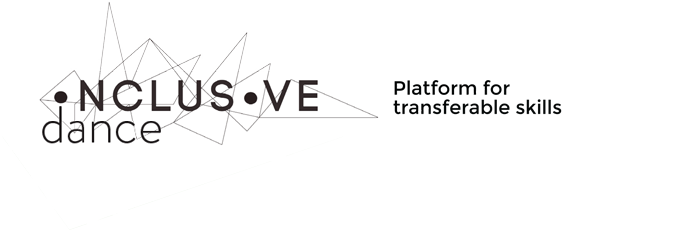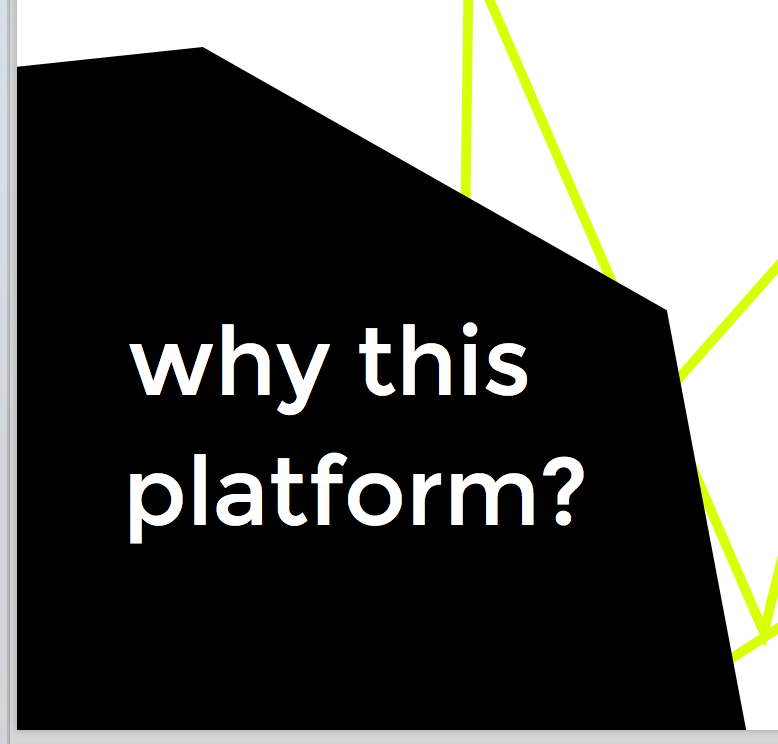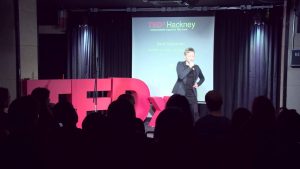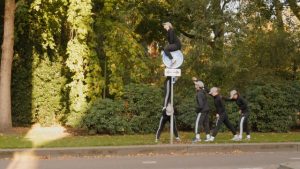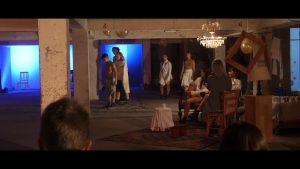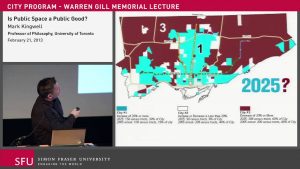| ICW | 15 april
2017 |
|
| Name: Ellis van Veldhuizen Cohort: 2013
Academic year: 2016-2017 Supervisor: Supervisor: Dirk Dumon |
International Choreographers Week | |
The ICW
Activities Survey:
This year, the International Choreographers Week (ICW) took place from Saturday 4 March – Wednesday 8 March. The week took off on Saturday evening with a Meet and Greet by the participants. There I met eleven of my (future) colleagues from the field of activity with whom I was going to share the ICW experience. Later that evening we witnessed a performance followed by a debriefing as feedback for the performers cum creators of the piece.
During this evening of introduction it struck me how diverse makers in the field of activity really are. This had a stimulating effect on me; it made me want to reflect more actively on my role as a maker and creator, and what my surplus value was going to be; an issue that today is still part of my coaching sessions with Arno.
Sunday included workshops by Guy Cools, a writer and dramaturge who has been active in the professional field of activity for a long time. During this first day of workshops he focused on rhythm and structures, paying attention to the individual rhythm, the things we were doing in our lives, what we were striving for, but also how a rhythm was received: the interaction between the narrator and the (active) listener. During the Monday workshop we were going to dig deeper into these various roles. On this day, the concept of rhythm soon took on a larger meaning than that of a mere succession of actions. Our bodies and the world around us carry rhythms by way of natural phenomena and through (social) structures.
This evoked certain questions: How do artists adapt to the social structures and the changing society? What influence do they have and how do they affect the rhythm of their work? In what way was this going to affect me? Does a change of rhythm have an effect on the roles we take on as a human being? I found these questions interesting and in line with the theme of the week: the different generations and how they evolve. Later that week, during the Monday evening group discussion, I received an overall response, as was the case during the lecture by Pascal Gielen on Tuesday morning. However, the question of how the rhythm in an artistic work and the work processes of makers has changed through the years has not been answered yet.
After a speech-listen assignment we were handed two techniques we had to apply to structure the concept at hand: through an association assignment of two words in a triangular connection, leading conjointly to a new one; and by drawing a map that might outline the structure of our work.
Two assignments included other (art) disciplines, language and architecture, as part of our artistic research. This had a liberalizing and illuminating effect. It opened a door inside of me and that made it possible to deal with my (pre-) research in a more capricious way. It created possibilities to embark on a search for new approaches regarding my my concept; approaches that might serve as an inspiration or the possibility to observe the total concept from a different perspective, and thus be able to crystallize it more aptly.
Subsequently we tried to find out what kind of rhythms we, as a group, had in our bags by spreading them out all over the space. This led to the discovery of the notions of the element of surprise and recognition: the two things that captured our focus the most during the process of investigating the things in the room; this is also what an audience is trying to find in art. These elements capture the audience’s attention. Recognition is a popular element in traditional arts, and surprise is fashionable in contemporary art. I discovered that, at the moment, I occupy myself profoundly with recognition or submissiveness and comprehensibility. This is partly due to Eddy’s lectures on convenientia. I find it interesting to dig deeper and more focused into the element of surprise in my work. In what way can I combine the element of surprise with the submissiveness in my current research through movement?
Once more my conscious search for the elements of recognition and surprise was accentuated during the following exercise in which we had to structure the objects in the room involving three ‘performers’ simultaneously. . Each one of those three had to take turns in placing or shifting an object until he/she was satisfied with the result. The structure of the assignment (1-2-3-1-2-3-..et cetera), in addition to the interaction of the three performers, evoked in me, as a member of an audience, certain expectations, expectations that were either fulfilled or remained unfulfilled. Thus every participant demonstrated a personal way of playing with the notions of recognition and surprise, based solely on his/her own creativity.
I noticed this, as a spectator, because the focus of this play was predominantly on the objects; as a result there were moments when the boundaries between the performer and the object were overstepped. Objects presented themselves as performers because of their expressiveness, like for instance when a shoe was deserted while still in motion, or a performer was objectified when, all of a sudden, he remained a permanent feature on the stage floor.
In this exercise various roles turned up again, such as those of manipulator, performer, object and audience. How I, as a spectator, would tackle this division of roles depended on how actively the person was involved in what was going on, on stage. However, as a performer / manipulator, my experience was a different one. I did not pay any attention to the performance as such; I focused on the various tableaus that occurred. As if there existed a functional relationship between me and the images. I tried to connect the various scenes my colleagues created. However, through a convergence of actions and reactions, I found myself, at some point, in three roles simultaneously: manipulator, object and performer. This was caused by the fact that I was introduced as an object by Christina after which I myself had to rearrange the space which widened my options to that of manipulator and performer as well.
During the evening session Guy gave a lecture on dialogues, a theme that would return on Monday. Again he referred to the function of listening. He differentiated between consuming and actively receiving and being receptive to a transfer of knowledge. Being aware of these phenomena provides freedom to accept new perspectives as a human being and as a maker.
As a result, I wonder how this system can be used during a performance because then there are also multiple perspectives: performers versus audiences. What does it take to make these individuals find each other, and to transfer knowledge? At what levels does a dialogue emerge? Is there such a thing as a non-verbal dialogue, or an artistic dialogue? Does this require an interactive performance or is it also feasible in a traditional form? These are the questions I take with me for further research.
On Monday we began with a warming-up as a means of focusing on our ‘self’. According to Guy, this self creates work derived from one of the following three sources: 1. autobiographical urgency, 2. inspiration from location or society, 3. from other works of arts. He accentuated how autobiographical work can create a more intimate relationship with the audience because they can relate to the work through their own autobiography. In this way the audience gets more involved in the artistic work.
I think that everyone’s work is autobiographical; we choose themes we are connected with, myself included, but that does not guarantee that the audience feels connected to the work. What is more appealing: recognition or abstraction? Or where lays the balance between these two? Is there a difference between the various generations of audiences? Is this in accordance with the investigations of the various generations of artists; and what about cultural differences? What I learned from the group session, and what I already knew, to a certain extent, was that in our society people are over-informed. People are swamped by incentives through the internet and the many screens. However, as a consequence young people who get the most incentives are easily bored. They have not learned (yet) how to receive art and how valuable an open mind towards it can be. So perhaps appreciating art is something you have to learn…(take my parents: the more they are confronted with what I am doing, the more their understanding of what art in general is about increases, including abstract art). To what extent do I, as a choreographer, want to be responsible for this? Do I want to use my work to teach an audience how to appreciate art? At this moment in time I do not want to do that, but it might be valuable to keep in mind for the future. Ultimately, as a chorographer I am dependent on spectators.
Next, Guy had planned to go outside to investigate the visual and auditory rhythm of the outdoors environment . However, the weather did not permit to go outdoors, and so we stayed inside to do something similar there. We investigated three spots in the room and shared our findings with two colleagues. One of the reasons for Guy to do so was to create a mutual recollection in threesomes. This recollection was the basis for improvised movement, investigating the roles of ‘performer’, ‘witness’ and ‘audience’. These roles are dependent of how active one’s pose is and the level of responsibility one takes/gets. During the exercise we experienced the differences between these three roles in a consecutive organic flow.
I noticed how organically and successively these three different roles were adapted, including the matching awareness of the role’s function. However, I did also notice that, when I released myself from that conscious knowledge, the distinction between three different roles became somewhat blurred. To an ‘ignorant party’ the role of the audience might be turned into that of the performer, and thus the division between performer and witness vanished. This made me wonder how we define roles, from what perspective? How can the emotions of two individuals converge in a way that they see or experience a relationship in an equal fashion? Including the ignorant parties concerned? In what way can this enrich a performance or a concept?
After these active exercises, we were given some theoretical and to the point information on the notion of dialogue. This included an observation of what roles all parties involved had to adapt.
Information I can try and link to the question concerning to what extent a performance is a dialogue, including the work process leading up to the performance. How do I approach the dancer with regard to the dialogue connection? Do I wish to broaden this connection or not? This is an interesting way to analyze my mode of operation and contribution. It includes an ongoing interest in the dialogue between artists or performers and audiences.
Similar to the Sunday afternoon programme, we continued to do an exercise to learn how to structure our concepts (ideas). This time Guy asked us to draw the rhythms of the various aspects to our future work, i.e.: 1. Global line, 2. Visual development, 3. Auditory development, and 4. Personal choice of specific development. Thus he made us reflect on the importance of these various layers and what proportion they bear to the concept and the overall idea. Later on, we repeated the association exercise with the triangular relationship, but this time we did it in groups of three. This provided us with new input and associations from different perspectives.
Again, these exercises generated new inspiration and helped to sort out the existing information.
After dinner, we had a group conversation, a dialogue, organized by choreographers who had been around for a long time and those who were new in the field of activity. The idea was to try and find out what kind of changes and alterations had been brought about by the various generations. Soon, we were discussing the familiar dilemma of how our techniques change the world and why it keeps the audience from turning up and experiencing art (especially the young people).
However, the conversation did not go beyond the problems at hand; it was, as far as I am concerned, not particularly revolutionary and showed little reflection on the past-present-future trajectory. In hindsight, I would have liked to receive more information on practical systems artists are confronted with. How do these different generations feel about rules and regulations or practical restrictions as far as their artistic research is concerned? In what way do they affect their work? (But this has also to do with the fact that I have little experience in the professional field of activity). Apart from that, I would have liked to hear more about what kind of individual development has been achieved, as well as the kind of global developments that have taken place. Fortunately, the latter was the subject of a lecture by Pascal Gielen that took place the next morning.
On Tuesday morning we were given a lecture by Pascal Gielen, a sociologist who talked us through the overall changes of three generations of artists. In a nutshell he guided us through a period beginning in the seventies of last century to the present day. He did so by taking into consideration the ratio between the notions of ‘Domestic’ (the safe haven), ‘Peers’ (knowledge development, artistic growth), ‘Market’ (money and competition) and ‘Civil’ (public value). Through the years, this ratio underwent a transformation: the number of independent entrepreneurs increased because of this quest for freedom. But as a result, the number of insecurities and uncertainties grew as well. That is why the youngest generation, the present one, is once more looking for collectives to strengthen each other.
He raced through his lecture) (almost as if in a hurry) and spoke in general terms. Although things were pretty much in line with the questions I had earlier that week, it was not quite concrete enough. I shall have to consult the notes more frequently; perhaps things will fall into place after I have read his book.
In the afternoon Lotte van den Berg gave a workshop: a communication exercise in which we tried to tackle the question “Should we dissolve the borders between bodies?” seen through the eyes of the different generations in history. Dating back100.000 years, via the present days, to 100.000 in future.
We had formulated a question, but soon the group found itself in a flow that was not in line with this research. We were more focused on what living in these different eras entails. I found it difficult to position myself in this exercise because I did not have a clear view of what perspective or entrance to use without losing myself. The world has known so many dates and cultures, including so many different individuals, and the future has at least an equal number in store… Apart from that, the group did not think along the same lines; we all stuck to our own subjective view of the world which created differences of opinion. For sure this exercise was an experience of sorts but I did not feel enriched by it. Although it motivated me to purchase a book: Sapiens a brief history of humankind, written by Yuval Noah Harari.
In the evening we had another performance consisting of three short pieces: three different duets, each one the result of the collaboration between a musician and a dancer. In addition there was a photo exhibition. Wednesday was ICW’s day of reflection. It offered the opportunity to process and to use all week’s information in a self-selected way. This resulted in small-scale performances, research items and visual artwork. It put the people we had come to know in the course of that week in motion. At last we saw an image of everyone’s artistic character.
Unfortunately, I could not participate that day because of an injury. Had I been able to contribute, I would probably have worked with improvisation on the basis of my notes; to tackle and process this new knowledge from a familiar perspective: my movements; directed at a myriad of perspectives, a 360ᵒ approach.
Overall conclusion:
I already gave my personal findings in italics at the conclusion of each paragraph. These are summaries of the notes I took during these days. They are thoughts that continue to linger on in my head. To put it briefly, the week consisted of an abundance of information from which emerged many different perspectives. It challenged me to embrace a wider look with regard to the topics covered. It provided me with questions that kindled my appetite to carry on, both artistically and as an entrepreneur, but also for the benefit of my personal growth.
I also noticed that it took me a long time to process everything I had experienced; for a while it turned out to be an obstacle for my verbal communication. This is certainly something I have to deal with. Where others wanted more time before they expressed themselves in the course of a dialogue, my objective would rather be to share my findings more rapidly and to the point. I allow myself to go through the four stages of learning something new in a compelling way, according to what Guy shared with us: 1. Unconscious incompetence, 2. Conscious incompetence, 3. Conscious competence (not feeling at ease), 4. Unconscious competence.
It most certainly was an impressive and inspiring week and I would like to participate again in another year. It gave me so much more than I had anticipated; even now I draw new inspiration and thoughts from that week; ideas that have been sown recently and are allowed to grow for a long stretch of time.
